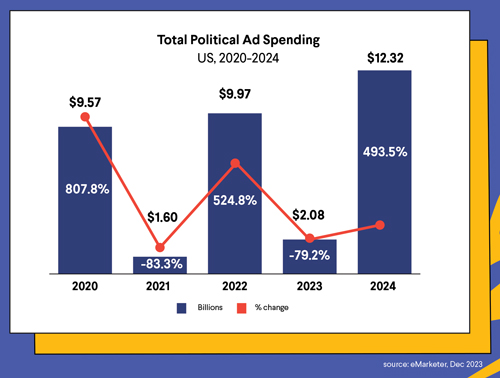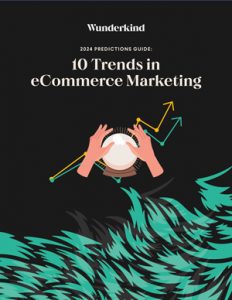Economic uncertainty and a growing expectation for seamless commerce continue to dominate
Staff
As we navigate the explosion in AI, data privacy and disruptive technologies, marketers are reimagining every stage of the customer lifecycle as well as their own organizational structures. With continued demands from internal stakeholders for growth, and external consumer pressure for better service and lower prices, marketers will continue to be challenged to rethink how they do business.
Wunderkind recently released a report identifying 10 trends that will have the biggest impact on digital marketers, and this article is based on the findings of that report. (For more details or to download a copy of the report, please see the end of this piece). While this report focusses on the U.S. retail market, there is no doubt the influence of these trends flows across the border into our market, while our own retail and ecommerce marketing efforts follow similar paths that empower strategy and tactics with technological evolution.
How Retail Evolves
Even with robust eCommerce sales, brick and mortar retailers are playing a bigger role in the omnichannel marketing process. At a time when shoppers can get most of what they need on Amazon, the ability to offer a high-quality, personalized experience is an important differentiator that retailers have been embracing. As technology and consumer expectations advance, in-store and eCommerce experiences will become even more sophisticated and integral to the retail landscape.
This trend is good for everyone. Shoppers benefit with a more convenient and personalized experience. Marketers forge deeper connections and build brand loyalty with recurring visits. Beauty behemoth Sephora has been doing this effectively for years. Associates on the selling floor are equipped with mobile devices with access to a shopper’s account and purchase history. They can instantly help a customer in need of a second tube of that perfect lipstick when the shopper cannot remember the name of the shade.
And even better: the sales associate can upsell the customer by knowing what other items the shopper has purchased in the past.
Target and Nordstrom have reorganized their stores’ footprints and the role of the store associate. There are larger areas for pickups and returns, and store associates are well-versed on how to direct an eCommerce shopper who is searching for the online returns or pick-up area. Whole Foods ensures that self check out areas are fully staffed. A customer service associate can be at a shopper’s check out kiosk within seconds if a scanner glitches or a digital payment method stalls.
Higher expectations for integrated AI will become more ubiquitous and 2 improve the customer experience
Retailers are increasingly using automated styling tools to boost customer satisfaction, minimize returns, and deliver a richer, more immersive experience to customers. Consumers can virtually try on clothing or visualize furniture in their homes before making a purchase. While this type of AI isn’t new, it’s becoming more commonplace. AI improves the customer experience while brands can simultaneously upsell and cross-sell complementary products.
“This technology could extend to in-store purchases as well,” explains Ken Pilot, founder of Ken Pilot Ventures, a strategic advisory and venture investment company focused on retail. “If a customer picks up a skirt in-store, the sales associate could pull it up on the site and help them complete the look in person. The customer could do this as well.”
Fashion brands that leverage this technology like Stylitics see up to 46x return on investment (ROI) and 320 percent average annual growth.
“The consumer experience from a merchandising and correlation perspective is going to get more sophisticated and thus better,” predicts Jeffrey Douglass, VP of Marketing at Weyco Group, an American footwear company. “For instance, in merchandising—if we show black dress shoes, we know to suggest other black dress shoes. Very large retailers might show items that aren’t necessarily correlated, but because of the algorithm and click data, they know that people buy those things together. There’s a higher probability of disruption in this particular field.”
AI is improving the customer experience when it comes to apparel sizes. “There are platforms that help customers measure size accurately. You take your iPhone, scan your body, and it will give the retailer your measurements so they can serve you the right sized products—and that all happens through machine learning,” Pilot explains. “Nailing size is going to continue to be more important. Returns are such a big problem for brands—especially items like denim and intimate apparel. Minimizing returns will be huge.”
Augmented reality (AR) plays a role in digital styling too. Companies like Sunglass Hut are leveraging AR to help close sales. With permission to use a customer’s mobile camera, the customer can “try on” sunglasses to see how they’d look on their face without ever putting them on in a store. The same goes for some furniture companies. Now you can see how a chair or table would look in your room courtesy of AR.
Fashion brands that leverage this technology like Stylitics see up to 46x return on investment and 320 percent average annual growth.
Baby boomers may not capture the attention of marketers the way Gen Z does, but there’s no changing the statistic that more than half of all wealth in the United States is held by Baby Boomers and the Silent Generation. Older generations have the most capital to spend, making them a primary target group for online retailers.
Social Media Usage among Baby Boomers
Researchers predict that in the next year 53 percent of boomers will regularly be using social networks. Facebook remains the most popular social media app for boomers, but platforms like TikTok, Snapchat, Reddit, and Instagram are gaining popularity.
This has given rise to lifestyle influencers like Barbara “Babs” Costello, the 73-year-old TikToker, who is “the internet mom/grandma you didn’t know you needed” with nearly four million followers. Or Gym Tan, a 62-year-old fashion executive who became an Instagram and TikTok star with her daughter’s encouragement. Tan offers fashion inspiration for women of all generations, with the largest segment being twentysomethings. It’s so lucrative she now devotes herself fulltime to creating content for Instagram and TikTok.
As consumers over the age of 60 maintain more active lifestyles and continue to embrace the conveniences of technology, marketers must create content, campaigns and promotions that not only engage these consumers, but feature them prominently with customized messaging. Knowing and trusting a brand is a top factor influencing purchase decisions for US adults, particularly among those ages 60 and older. Marketers must be authentic when targeting these consumers.
With their population size, social media activity, and roughly $2.6 trillion in buying power, the Baby Boomer market remains a high priority for businesses.
- Increased focus on targeting Boomer shoppers
- 53 percent of boomers will regularly be using social networks.
A recent global study found that eight in ten adults want more control over their identity on the internet and are advocating for enhanced data privacy rights. This includes the right to be informed about the data collected, the right to delete that data, and the ability to take legal action in cases of misuse. Compliance with these rights is becoming a focal point for businesses.
According to Insider Intelligence, more and more states are enacting laws that restrict the collection of personal information and give consumers more agency over how their data is used, favoring privacy protection over ad targeting and retargeting. “Privacy controls will continue to increase, but I think progressive brands will let customers openly own their data and decide how they want it used,” predicts Shelly Wilson, Senior Vice President of Digital at Saje Natural Wellness. “If a customer shares a lot of their information, but in exchange it saves them time, money and reduces email volume and non-relevant communication, there is a strong value exchange. Brands need to share how carefully they will protect data very soon as consumers will be voting not only with their dollars, but with their data.”
“Customers want to know their data is safe and secure, but they will give you their data if there is a true benefit to providing that info about themselves,”says Christi Korzekwa, founder and CEO of ABL Marketing and former Chief Marketing Officer at Tractor Supply Company. “A lot of customers want monetary value. The more I spend, the more money or points you’ll give me. But second to monetary value is knowledge—they want to be more informed on how to live a particular lifestyle. You have to dig into your customers’ psyches and determine what’s most important to them.”
Consumers will take more control over their personal data
Customers want to know their data is safe and secure, but they will give you their data if there is a true benefit to providing that info about themselves. A lot of customers want monetary value. The more I spend, the more money or points you’ll give me. But second to monetary value is knowledge—they want to be more informed on how to live a particular lifestyle. You have to dig into your customers’ psyches and determine what’s most important to them.” Christi Korzekwa, founder and CEO of ABL Marketing and former Chief Marketing Officer at Tractor Supply Company.
As digital privacy becomes more prominent and regulated, marketers and data teams are working more collaboratively. In an era where data protection is a significant concern, involving privacy professionals in marketing strategy discussions is crucial to ensure that campaigns adhere to regulatory requirements and respect user privacy.
The rise of privacy-first marketing
A privacy-first approach allows marketers to access the data they need to make insightful decisions but incorporates data privacy principles throughout the marketing process. It respects consumers’ personal rights, complies with major data privacy regulations, and safeguards consumer data from mismanagement or security breaches.
“Privacy, like security, is best when it is baked in from the start, not fixed after the fact,” says Anne Toth, trust, privacy and tech policy advisor, and member of the ISACA Digital Trust Advisory Council, when discussing the results of their Privacy in Practice 2023 survey report. “Our research underscores and validates what many practitioners know from experience to be true: privacy by design is a smart investment that pays dividends in customer trust.”
Marketers will become privacy champions
As data breaches become more common, consumers are becoming more discerning about the companies they choose to interact with. Businesses that prioritize data privacy are more likely to remain competitive.
A comprehensive understanding of data privacy empowers marketers to navigate the evolving landscape of digital marketing responsibly. It not only safeguards the interests of consumers but also protects the reputation and longevity of the business.
Privacy, like security, is best when it is baked in from the start, not fixed after the fact. Our research underscores and validates what many practitioners know from experience to be true: privacy by design is a smart investment that pays dividends in customer trust.”- Anne Toth, trust, privacy and tech policy advisor, and member of the ISACA Digital Trust Advisory Council
The eventual removal of third party cookies for data collection has been known for years. Yet marketers have been slow to adopt alternative solutions. In a recent webinar Jennifer Fleck, senior principal of global business advisory services at Slalom, cited internal stakeholder consensus as one of the key reasons businesses have waited so long to invest in a modernized marketing system. “We need to have some consensus around where this data lives, how it’s governed, how it’s operationalized, and who owns it.”
eMarketer reports that B2B marketing data spending will continue to grow through 2024. Technologies and methods to make better use of first-party data have come a long way and are giving brands more control of their customer retention and acquisition. Investment in first-party and 6 zero-party data will increase US B2B Marketing Data Spending, 2020-2024.

This year in the US means both a presidential and mid-year elections. This means political spending will flood the advertising markets with more than $12B, according to Insider Intelligence. Brands that lean heavily on paid channels to retarget consumers will find this tactic failing miserably as the year progresses.
With a projected 362 percent increase in digital spending alone from 2023 figures, marketers can expect scarcity in ad inventory as well as skyrocketing costs as they compete with massive political ad budgets. Furthermore, consumers will continue to turn a blind eye to ad units as they get pummeled across their digital journey. Brands that can leverage owned channels such as email and sms will stand out and win.
- Adding a strong identity partner increases marketers ability to reach more consumers across these channels.
- Political ad spends will wreak havoc 7 on retargeting tactics for brands
- 362 percent projected 362 percent increase in digital spending alone from 2023 figures
Total Political Ad Spending

Ethical AI focuses on developing and deploying AI systems that prioritize fairness, transparency, accountability, and respect for human values. The emphasis is on avoiding harm and promoting responsible AI use.
“Retailers have a lot of data around their customers,” says Christi Korzekwa, Founder and CEO of ABL Marketing and former Chief Marketing Officer at Tractor Supply Company. “You’re going to see them using AI to consume that data more swiftly and generate actionable insights that will allow them to drive their business forward.”
In late 2023, Walmart unveiled its Walmart Responsible AI pledge. In a recent blog Walmart’s SVP Nuala O’Connor, and chief counsel, digital citizenship wrote “The Walmart Responsible AI Pledge is about more than just AI. It is a moment in time for us to speak directly to our customers, members and associates; be transparent and address the concerns they may have with the rapid pace of technological innovation; and reinforce our commitment to using technology in ways that are safe and beneficial to them. And by leading in this space, we hope to pave the way for adoption of ethical AI in retail.”
According to a recent Gartner survey, 34 percent of organizations are either already using or implementing AI security tools to mitigate the accompanying risks of generative AI generative AI, artificial intelligence capable of generating text, images and other media.
The rise of ethical AI
“What we’re seeing is an increased need for ethical AI,” explains John Bates, Vice President of Product at Wunderkind. “There’s explicit consent that data subjects can give around the collection and use of data, but sometimes there is synthetic data that can be created based on the intelligence of these algorithms. Some of these models are so good that they can predict your gender, income, race, etc. How do you balance out explicit consent for that personal identifiable information (PII) with pseudo PII that gets derived by models and is getting increasingly more accurate? They’re going to need to figure it out.”
Retailers have a lot of data around their customers. You’re going to see them using AI to consume that data more swiftly and generate actionable insights that will allow them to drive their business forward.” – Christi Korzekwa, founder and CEO of ABL Marketing and former Chief Marketing Officer at Tractor Supply Company.
AI will disrupt not just the technology that marketers use, but also the business models with which marketers engage vendors. “The subscription vendors will die,” says Richard Jones, Chief Revenue Officer at Wunderkind. “The companies that sell outcomes will replace subscriptions.”
Many tech companies have a business model in which they sell seats to their platform, and regardless of how much a customer uses it (like an ESP where you could send one email or a million emails per month), you pay the same prefixed amount. On the other hand, companies that guarantee outcomes (leads, conversions, or revenue) where the customer doesn’t pay until that guarantee is met, will be positioned to win in 2024 and beyond.
Many legacy vendors will find it nearly impossible to move to an outcomes-based, AI-powered business model because of the amount of revenue they have tied up in subscriptions. Tim Glomb, VP Digital, Content and AI at Wunderkind, says “We predict up to 50 percent of niche martech SaaS vendors will fail in the next few years because of this.”
“Towards the end of 2024, we’ll start to see the rise of autonomous marketing platforms,” Jones adds. “AI is the disruption; the impact is autonomous marketing. This will attack the Microsoft Clippy-style, AI-assisted mentality.” This means platforms with unique, proprietary datasets that can feed AI engines that are powering their core value and offerings are poised to truly disrupt existing models and accelerate the impact they provide for brands.
AI will impact business models and how 9 brands work with martech vendors
“We predict up to 50 percent of niche martech SaaS vendors will fail in the next few years because of this” -Tim Glomb, VP Digital, Content and AI, Wunderkind
Brands that are investing in long-term organic growth strategies are better poised for revenue growth and for buffering themselves against rising customer acquisition costs. Paid channels like Google and Facebook advertising have seen lower engagement and conversion rates as consumers become increasingly intolerant with intrusive content.
Many eCommerce marketers are leveraging owned channels and first-party data amidst shrinking budgets for smarter, scalable growth. While paid channels yield a more immediate lift, organic channel growth is more steady, more trustworthy and more consistent. Paid content helps your marketing efforts via broad and immediate exposure. Organic users often share quality content, amplifying your brand awareness through word-of-mouth. Paid display ads, for example, don’t generally lead to customer referrals; they must leverage retargeting to consistently remind potential consumers about the brand.
Marketers are seeing a decline in the ROI of legacy paid channels like Facebook and heightened concern about unsafe digital brand environments. Glomb says, “There is a real need to identify and invest in the channels Brands are re-prioritizing their owned channel experiences versus paid channels that deliver efficient revenue growth. Those who focus on collecting and leveraging zero- and first-party data to personalize content and offers across their owned channels will find email, sms and their own digital properties acting as robust, customer-centric growth engines. Those who nail this will be the marketing leaders of tomorrow.”
The role of the marketer will continue to evolve in 2024 as the pressure rises to deliver efficiencies, value and growth. Technology will impact every touch point of customer relations and give rise to internal teams with increasingly diverse skill sets. Now more than ever, the right marketing partner could mean the difference between survival and success.
 Wunderkind is a leading performance marketing solution that delivers guaranteed revenue. Brands, publishers, and advertisers confidently use Wunderkind to grow customer relationships and revenue through one-to-one messages across their website, email, texts, and ads. This article is based on a report and is not sponsored content. https://convert.wunderkind.co/2024-marketing-predictions-guide
Wunderkind is a leading performance marketing solution that delivers guaranteed revenue. Brands, publishers, and advertisers confidently use Wunderkind to grow customer relationships and revenue through one-to-one messages across their website, email, texts, and ads. This article is based on a report and is not sponsored content. https://convert.wunderkind.co/2024-marketing-predictions-guide




